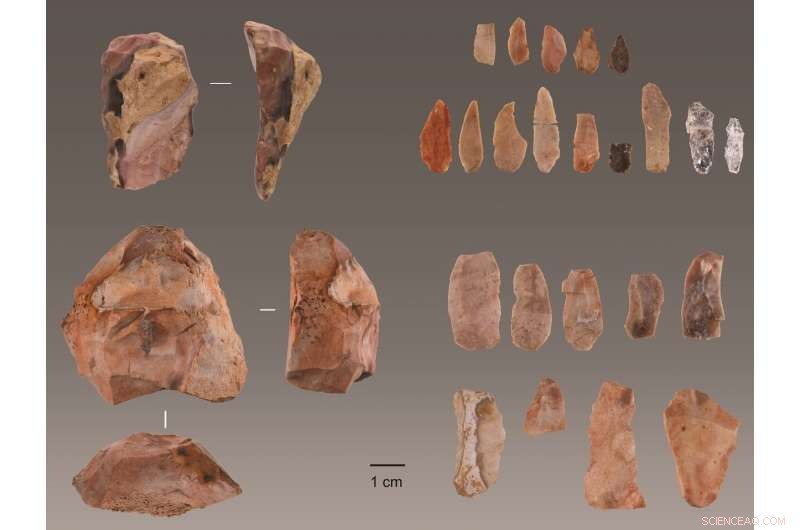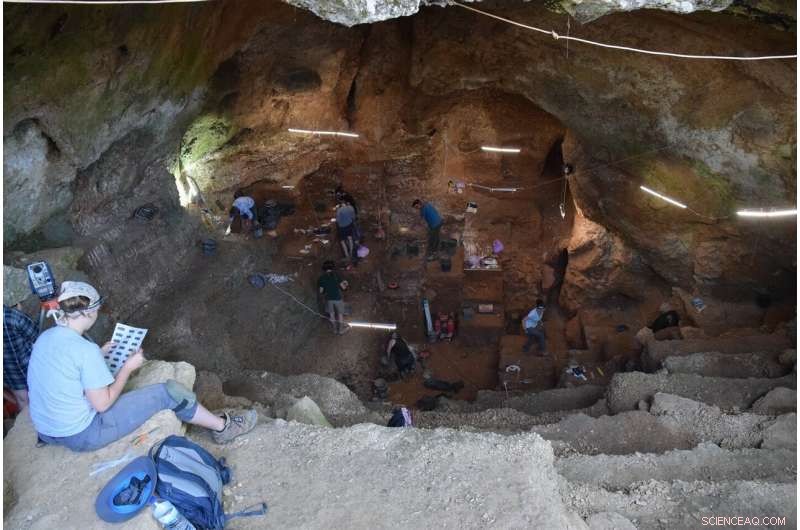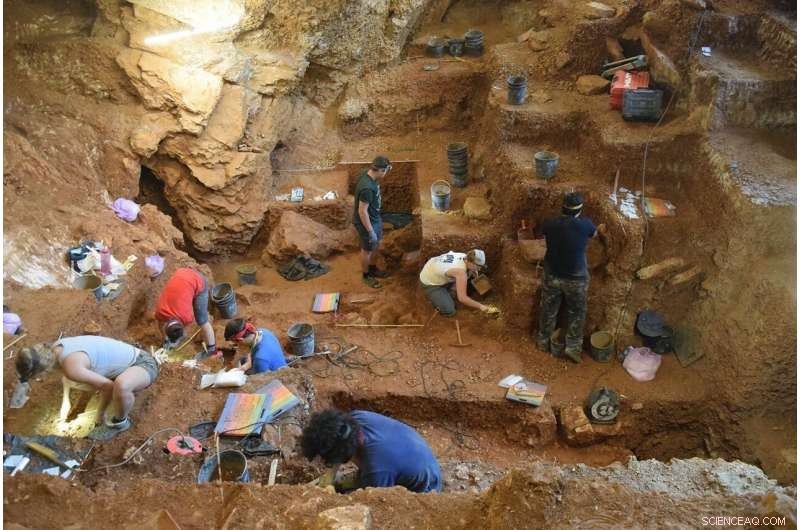
Ferramentas descobertas na Lapa do Picareiro, no centro de Portugal. Crédito:Jonathan Haws.
Os humanos modernos chegaram na parte mais ocidental da Europa 41, 000-38, 000 anos atrás, por volta de 5, 000 anos antes do conhecido anteriormente, de acordo com Jonathan Haws, Ph.D., professor e presidente do Departamento de Antropologia da Universidade de Louisville, e uma equipe internacional de pesquisadores. A equipe revelou a descoberta de ferramentas de pedra usadas por humanos modernos datadas do período anterior em um relatório publicado esta semana na revista. Proceedings of the National Academy of Sciences .
As ferramentas, descoberto em uma caverna chamada Lapa do Picareiro, localizado perto da costa atlântica do centro de Portugal, conecte o site com descobertas semelhantes em toda a Eurásia e na planície russa. A descoberta apóia uma rápida dispersão de humanos modernos pela Eurásia em alguns milhares de anos após seu primeiro aparecimento no sudeste da Europa. As ferramentas documentam a presença de humanos modernos no extremo oeste da Europa, em uma época em que se pensava que os Neandertais estavam presentes na região. A descoberta tem ramificações importantes para a compreensão da possível interação entre os dois grupos humanos e o desaparecimento final dos Neandertais.
"A questão de saber se os últimos Neandertais sobreviventes na Europa foram substituídos ou assimilados por humanos modernos que chegam é uma questão de longa data, questão não resolvida na paleoantropologia, "disse Lukas Friedl, um antropólogo da University of West Bohemia em Pilsen, República Checa, e co-líder do projeto. "As primeiras datas das ferramentas de pedra Aurignaciana em Picareiro provavelmente excluem a possibilidade de que os humanos modernos tenham chegado à terra há muito desprovidos de Neandertais, e isso por si só é emocionante. "
Até agora, a evidência mais antiga de humanos modernos ao sul do rio Ebro, na Espanha, veio de Bajondillo, um sítio de caverna na costa sul. A descoberta de fezes de pedra caracterizadas como aurignacianas, tecnologia associada aos primeiros humanos modernos na Europa, em um contexto estratigráfico seguro em Picareiro fornecem evidências definitivas da chegada do homem moderno.
"Bajondillo ofereceu evidências tentadoras, mas controversas, de que os humanos modernos estiveram na área antes do que pensávamos, "Haws disse." As evidências em nosso relatório definitivamente apóiam as implicações de Bajondillo para a chegada de um homem moderno, mas ainda não está claro como eles chegaram aqui. As pessoas provavelmente migraram ao longo dos rios que correm leste-oeste no interior, mas uma rota costeira ainda é possível. "
"A disseminação de humanos anatomicamente modernos pela Europa, muitos milhares de anos atrás, é fundamental para nossa compreensão de onde viemos como uma espécie agora global, "disse John Yellen, diretor do programa de arqueologia e arqueometria da National Science Foundation, que apoiou o trabalho. "Esta descoberta oferece novas evidências significativas que ajudarão a moldar pesquisas futuras, investigando quando e onde os humanos anatomicamente modernos chegaram à Europa e quais interações eles podem ter tido com os neandertais."

Vista da Lapa do Picareiro vista da entrada. Crédito:Jonathan Haws
A caverna do Picareiro está em escavação há 25 anos e produziu um registro de ocupação humana nos últimos 50, 000 anos. Uma equipa de investigação internacional do Centro Interdisciplinar de Arqueologia e Evolução do Comportamento Humano (ICArEHB) em Faro, Portugal, está investigando a chegada de humanos modernos e a extinção dos neandertais na região.
O projeto é liderado por Haws, Michael Benedetti, da University of North Carolina Wilmington, e Friedl, em colaboração com Nuno Bicho e João Cascalheira da Universidade do Algarve, onde ICArEHB está alojado, e Telmo Pereira da Universidade Autônoma de Lisboa.
Com o apoio da U.S. National Science Foundation, doa Haws e Benedetti, a equipe descobriu ricos depósitos arqueológicos que incluem ferramentas de pedra em associação com milhares de ossos de animais de caça, açougue e atividades culinárias.
Sahra Talamo da Universidade de Bolonha, Itália, e o Instituto Max Planck de Antropologia Evolucionária em Leipzig, Alemanha, juntou-se à equipe de pesquisa para determinar a idade das ocupações do homem moderno e dos Neandertais. She used state-of-the-art bone pretreatment and accelerator mass spectrometry (AMS) to date the bones that show evidence of butchery cut marks and intentional breakage by humans to extract bone marrow, a highly prized and nutritious food consumed by ancient people. The dating results place the modern human arrival to the interval between 41, 000 and 38, 000 anos atrás. The last Neanderthal occupation at the site took place between 45, 000 and 42, 000 anos atrás.
"The radiocarbon results from Lapa do Picareiro are not only very precise in terms of the dating method, but also demonstrate the meticulous work of the archeologists at the site, " Talamo said. "The importance of collaboration between the radiocarbon specialist and the archaeologists is essential in order to obtain an accurate chronology like in the case of Picareiro."
Spatial analysis of high-resolution three-dimensional data confirmed the precise stratigraphic relationships between artifacts and radiocarbon samples and revealed discrete layers of occupation at the site.
"Analysis of high-resolution spatial data is crucial for documenting and observing lenses of human occupation and reconstructing occupational patterns, especially in cave environments where complex formation processes exist, " said Grace Ellis, um Ph.D. student at Colorado State University studying landscape archaeology and ancient settlement patterns.

View of the excavation of the early modern human (foreground) and Neanderthal layers (background) of Lapa do Picareiro. Credit:Jonathan Haws
This was backed up by artifact refitting that showed the stone tools were not moved through post-depositional processes.
"Refitting is a task that requires a lot of time and patience, e neste caso, it really was worthwhile because the results verified the geospatial observations, " said Pereira, an archaeologist who specializes in stone technology.
While the dates suggest that modern humans arrived after Neanderthals disappeared, a nearby cave, Oliveira, has evidence for Neanderthals' survival until 37, 000 anos atrás. The two groups may have overlapped for several thousand years in the area.
"If the two groups overlapped for some time in the highlands of Atlantic Portugal, they may have maintained contacts between each other and exchanged not only technology and tools, but also mates. This could possibly explain why many Europeans have Neanderthal genes, " said Bicho, director of ICArEHB.
"Besides genetic and archeological evidence, high-resolution temporal context and fossil evidence across the continent is crucial for answering this question. With the preserved key layers dated to the transitional period, we are now awaiting human fossils to tell us more about the nature of the transition, " Friedl said.
Despite the overlap in dates, there does not appear to be any evidence for direct contact between Neanderthals and modern humans. Neanderthals continued to use the same stone tools they had before modern humans arrived, bringing a completely different stone technology.
"Differences between the stone tool assemblages dated before and after about 41, 000 years ago are striking at Picareiro, " said Cascalheira, an ICArEHB board member and specialist on stone tool technology. "Older levels are dominated by quartzite and quartz raw materials and marked by the presence of Levallois technology, a typical element of Neanderthal occupations in Europe. Aurignacian levels, por outro lado, are dominated by flint and the production of very small blades that were likely used as inserts in arrow shafts for hunting."
Flint also was used to make tools for butchering animals such as red deer, ibex and possibly rabbits. The team recovered a few red deer canine teeth, often used as personal adornments, but so far these do not show traces of manufacturing jewelry.
"The bones from Lapa do Picareiro make up one of the largest Paleolithic assemblages in Portugal, and the preservation of these animal bones is remarkable, " said Milena Carvalho, um Ph.D. candidate at the University of New Mexico and ICArEHB researcher studying the diets and paleoecology of Neanderthals and modern humans. "The collection will provide tremendous amounts of information on human behavior and paleoecology during the Paleolithic and we will be studying it for decades."
The cave sediments also contain a well-preserved paleoclimatic record that helps reconstruct environmental conditions at the time of the last Neanderthals and arrival of modern humans.
"We studied changes in the size of limestone clasts and the chemistry of muddy fine sediment filling the cave to understand the paleoclimatic context for the transition, " Benedetti said. "Our analysis shows that the arrival of modern humans corresponds with, or slightly predates, a bitterly cold and extremely dry phase. Harsh environmental conditions during this period posed challenges that both modern human and Neanderthal populations had to contend with."
The cave itself has an enormous amount of sediment remaining for future work and the excavation still hasn't reached the bottom.
"I've been excavating at Picareiro for 25 years and just when you start to think it might be done giving up its secrets, a new surprise gets unearthed, " Haws said. "Every few years something remarkable turns up and we keep digging."